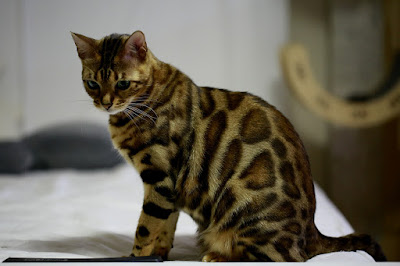Babying Your Bengal
Your friend informed you of this wonderful breeder in your area and the litter of extremely cute kittens he has. A friend of a friend or your Uncle Harry perhaps, briefs you that these cats are the best you can have around you but that they need to be treated like your own children. What kind of cat is this? A Bengal! What is it about these cats that allow folks fascinated and cause them to admire these little ones so much?
Well, first and foremost is their intriguing background. These cats are in fact the offspring of the first cross-breeding of an Asian leopard cat with numerous domestic cats. Some used to refer to this magnificent little animal as the “Leopardette” while others designated it the “Bengali.”It appears that we can thank Mrs. Jean Mill for this cat since in the 1980s she acquired some of them from a geneticist and then bred them with some feral cats." The results are magnificently spotted or striped animals. Their fur is the first tip-off to their ancestry since it is a very thick pelt that may have spots and sometimes even carrying the signature stripes of the tabby. Colors may vary from nut-brown to a faint tan or gold.
These cats actually still have the look of the wild in their eyes, and an enthusiasm for life and exploration to match. Nonetheless, they do have the domesticated cat’s temperament and are a good match for active people and families. They are small animals, weighing in at less than fifteen pounds, and usually reaching only about eight pounds. One of the most amazing aspects of this breed is its fondness for water. Usually, a cat will turn into a hissing ball of fur, claws, and teeth if brought within the vicinity of water, yet this breed actually loves playing in water if given a chance!
If you have finally fallen in love with the perfect little kitten, it is time to consider the best place to put her when you introduce her to her new home and family. Ideally, you will confine her to a small room for the first couple of days; this way, she will have an easy time identifying her food dish, what it is that you are giving her as food in the first place, her water dish, as well as her litter box. Additionally, this will permit her to learn which of the accommodations in your home her bed is. By confining her to this small room, you are permitting the kitten to have quick and easy access to all the little things she needs, and she will not have to go looking through a whole big new world for her litter box. The quicker the latter is identified, by the way, the easier the box training will be.
Should your kitten instead go off and do her business behind the sofa or under the kitchen table, it will be so much harder to discourage her from doing so in the future, especially since the smell will be there? Similarly, you will want to establish early on if your little Bengal is allowed on the couch, bed, or easy chair, or if she will have to sleep only on her little kitty bed. Since these cats are fond of a soft lap and some snuggling, you may want to consider giving her couch and bed privileges.
Food is another big aspect of pampering your little feline. Be certain to purchase a high-quality chow, and also feed at the age-appropriate stages. Kitten food should be given until the cat is at least one year old. If you are breeding your cat, you will also want to feed this high fat and high protein mix to your pregnant or lactating cat. Conversely, you may wish to supplement dry food with canned food and by doing so you will offer your kitty a wonderful variety of flavors! Of course, remember your kitten may become spoiled and may not want to go back to the dry food once she has tasted the wet food. Overall, baying your Bengal is very easy, give her lots of love and attention, some good food, a soft bed, and you will have a happily purring kitten on your hands!








0 Comments
Spams Denied! Ask and Discuss healthy things